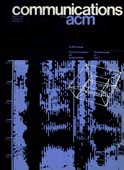Scanned-display computer graphics
A television-like scanned-display system has been successfully implemented on a Honeywell DDP-224 computer installation. The scanned image is stored in the core memory of the computer, and software scan conversion is used to convert the rectangular coordinates of a point to the appropriate word and bit in an output display array in core storage. Results thus far indicate that flicker-free displays of large amounts of data are possible with reasonably fast graphical interaction. A scanned image of size 240 X 254 points is displayed at a 30 frame-per-second rate.




